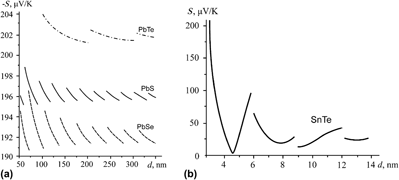Published online by Cambridge University Press: 16 February 2012

The thermoelectric parameters have been investigated depending on the thickness of the layer of nanostructures IV–VI (PbS, PbSe, PbTe, and SnTe). Based on the theoretical model of quantum well (QW) with infinitely high walls, it is demonstrated that this model explains nonmonotonous behavior of the Seebeck coefficient S with the change of the well width. On the basis of oscillation period Δdexp, we have approached the theoretical d-dependence of the coefficient S to the experimental one and defined the value of the Fermi energy in the corresponding nanostructures. It has been established that the minimum QW width dmin, where the first energy level coincides with the Fermi energy, is equal to the oscillation period of the Seebeck coefficient in this structure.